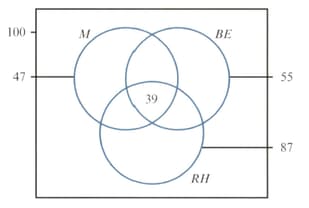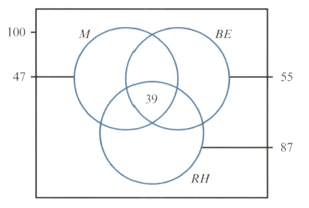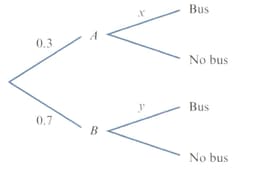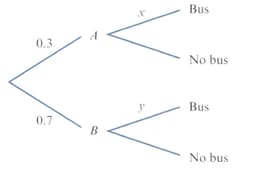When they are switched on, certain small devices independently produce outputs of or volts with respective probabilities of and . Find the probability that three of these devices produce an output with a sum of or volts.

Important Questions on Probability
One hundred people are attending a conference. The following Venn diagram shows how many are male , have brown eyes and are right-handed .

Given that there are males with brown eyes, right-handed males and 46 right-handed people with brown eyes, copy and complete the Venn diagram.
One hundred people are attending a conference. The following Venn diagram shows how many are male , have brown eyes and are right-handed .

Two attendees are selected at random. Find the probability that they are both females who are not right-handed. [correct up to five decimal places]
One hundred people are attending a conference. The following Venn diagram shows how many are male , have brown eyes and are right-handed .

Two attendees are selected at random. Find the probability that exactly one of them is right-handed, given that neither of them have brown eyes. [correct up to three decimal places]
A student travels to college by either of two routes, or . The probability that they use route is , and the probability that they are passed by a bus on their way to college on any particular day is . They are twice as likely to be passed by a bus when they use route as when they use route .

Use the tree diagram opposite to form and solve a pair of simultaneous equations in and .
A student travels to college by either of two routes, or . The probability that they use route is , and the probability that they are passed by a bus on their way to college on any particular day is . They are twice as likely to be passed by a bus when they use route as when they use route .

Find the probability that the student uses route , given that they are not passed by a bus on their way to college. [correct up to three decimal places]
Two ordinary fair dice are rolled. If the first shows a number less than , then the score is the mean of the numbers obtained; otherwise the score is equal to half the absolute (non-negative) difference between the numbers obtained. Find the probability that the score is:
positive
Two ordinary fair dice are rolled. If the first shows a number less than , then the score is the mean of the numbers obtained; otherwise the score is equal to half the absolute (non-negative) difference between the numbers obtained. Find the probability that the score is:
greater than , given that it is less than
Two ordinary fair dice are rolled. If the first shows a number less than , then the score is the mean of the numbers obtained; otherwise the score is equal to half the absolute (non-negative) difference between the numbers obtained. Find the probability that the score is:
less than , given that it is greater than
